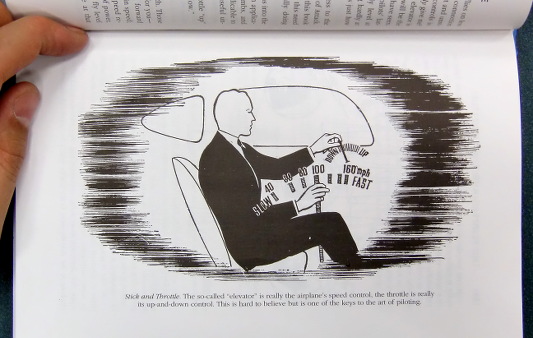March 22, 2013
Any time a beginner asks what to read about flying an airplane, someone suggests "Stick and Rudder: An Explanation of the Art of Flying" by Wolfgang Langewiesche. It happened to me too. But when I picked it up in Barns & Nobble, I found it unreadable. The style was just that wordy. I went with "How It Flies", and was none the worse for it. John Denker's fine book is exactly what works best if you are a physist or engineer.
Well, times change, and I wanted to have something to read before bed, so I gave "Stick and Rudder" another try. Now that I am not anxious to extract information and just read for fun, it's not that bad. The Greatest Generation writing style is actully quite amusing. And you just look at this:

It's a gentleman pilot, flying in a business suit!
Aside from amusement, I extracted a few bits of information, too. First and foremost, I imagined that the effect from the different wingtip speeds in a turn must be must larger than it actually is. But Mr. Langewiesche drew my attention to the fact that most of the adverse yaw comes from aileron deflection. No deflection - no yaw, and no rudder input! It bothered me quite a bit when I flew John's Interstate S1A. In a Cherokee, you typically have to keep a certain rudder in when turning, no matter what. Now it all makes sense.
In addition, there's a little confirmation that you should (almost) always take off downhill. Nothing a bush pilot won't know, but still.
Some of the information was a little odd. For example:
The speedier ship also needs more time to turn around in! If you fly twice as fast as need (as any given bank) twice as much time to accomplish a given change in direction.
I can understand that the radius of the turn is going to be differnt, but why the difference in turn rate? If it were the case, your T&B would be placarded at what speed to fly the standard rate turn. But it's not, is it? This is something I need to figure out from the basics.
UPDATE: Brian Morrison comments:
The turn and bank doesn't need a placard because it measures rate of turn, not bank angle and therefore automatically corrects for changes in airspeed/turn rate.
Posted by: Pete Zaitcev at
09:08 PM
| Comments (1)
| Add Comment
Post contains 398 words, total size 2 kb.
Remember the rule of thumb that the bank in a standard rate turn is approximately 15% of the airspeed. So if you increase the speed for any given bank, the rate of turn will decrease.
The turn and bank doesn't need a placard because it measures rate of turn, not bank angle and therefore automatically corrects for changes in airspeed/turn rate.
Posted by: Brian Morrison at April 15, 2013 12:35 PM (xBqO1)
25 queries taking 0.0263 seconds, 29 records returned.
Powered by Minx 1.1.6c-pink.




